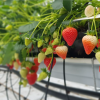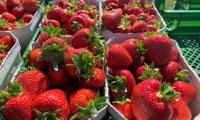Verdi is a mid-early Junebearer from teh Fresh Forward programme. It...
Fandango
Fandango
- Highly sweet & aromatic taste
- Bright red colour
- High Brix levels throughout the season.
- Good shelf life
- Low acid levels
- Great picking speed
- Upright calyx
Plant characteristics
Fandango is a new early short-day variety from Fresh Forward selected for the Mediterranean climate. The plants are generally healthy and vigorous, with a balanced production. In Southern Spain Fandango plants should be planted before 15th October. The picking speed is promoted by the open plant habit and long trusses, which averagely contain six well branched flowers.
Yield curve
Fandango starts fruit production almost as early as Fortuna (5 to 7 days later) although the total yield is slightly lower than Fortuna. The fruit production is relatively stable and fewer peaks and gaps than with Fortuna should be expected. In addition, Fandango has a higher percentage of Class 1 fruit than Fortuna.
Fruit characteristics
The berries are large, conical and exceptionally uniformly shaped. The fruit weights are comparable to Calinda during most of the season, although Fandango shows an earlier decline in fruit weight to medium fruit size towards the end of the season. The achenes are located slightly deeper in the fruit skin than Calinda, resulting in an appealing and smooth fruit skin.
Although the fruits are firm, the inner texture is pleasantly soft. Both smell and taste are very sweet and aromatic, and acidity levels are lower than in Calinda. Shelf-life trials show that the fruit colour and gloss are well preserved in storage.
Disease tolerance
Fandango is fairly resistant to Phytophthora cactorum. Furthermore, disease inoculation trials indicate that Fandango is moderately tolerant to powdery mildew (Podosphaera macularis) and susceptible to Verticilium spp, although no problems have been observed in practice so far.








